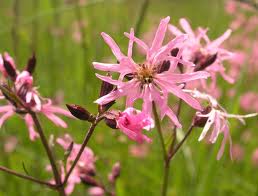





A genuine water meadow is a natural extension of a river, being the winter flood plain which, during summer, is often constantly damp and produces a lush crop of grass. Traditionally, water meadows have been grazed, and the plants that live in them have either benefited from the grazing or have been by-passed by the animals. They are places where self seeding occurs and there is a natural regeneration of the attractive flowering plants.
In many ways, a water meadow is akin to an alpine meadow and, like that habitat, is predominantly a spring and early summer feature.
This is an advantage, for it will be well into summer before the floral show in the water garden itself really gets under way. However, a potential problem is that it is difficult to keep a water meadow looking tidy from mid-summer onwards: if the meadow is to flourish naturally, you will need to establish some sort of compromise between allowing the decorative plants to seed into the sward and keeping the grass under control.
Much can be done to make the situation tolerable by cutting neatly around and through the area to create sculpted shapes in the grass, in the same way that a lawn containing naturalized bulbs would be mown. This leaves long grass, but neatly manicured edges, and with an occasional swathe cut through for a path, the meadow can become an interesting addition to the garden. This is particularly true if you are interested in wildlife, for the natural mix of vegetation will encourage insects, especially tiny moths and butterflies.
As an adjunct to the water garden, the water meadow is superb, allowing the tangled informality of the natural pond to spread out into the garden. When linked to a wildlife water feature, it rarely looks scruffy or ill at ease. Only if you try to incorporate a meadow with the more manicured water garden, especially the formal water feature, will it look alien.
Provided that the sward is predominantly grass and not a mixture of weedy vegetation, a water meadow can be very beautiful. The grass should be of a type that can be mown satisfactorily, for although in the countryside clumps of tussock grass and rushes will invade the water meadow, they are rarely appealing in a garden setting and will cause mowing problems. A good clean cut towards the end of the summer, and consistent mowing until the first sharp frost, will ensure recovery of the turf, guaranteeing a wonderful green foil for the early flowering plants of spring.
There can be few more beautiful sights than the cuckoo flower (Cardamine pratensis), with its pale lilac flowers and fern-like foliage, spreading from the bog garden into the water meadow. Allow it to mix with the snakeshead fritillary (Fritillaria meleagris), planted in informal groups right up to the water’s edge. Few gardeners consider bulbs as plants for wet places, but the snakeshead fritillary always looks its best when scattered among lush grass in very damp conditions.

Ragged robin (Lychnis flos-cuculi) is the star of the summer water meadow, with its strong wiry stems and starry, somewhat spidery red flowers. The foliage is rarely noticeable when growing among grass, which is useful since it is not particularly attractive. Allow ragged robin to spread naturally, scratching away a few patches in the turf, during late summer, into which it can self seed. Use water avens (Geum rivale) as companion plants to ragged robin; they are so different in habit and appearance that they complement each other beautifully. They are not fiercely competitive and will grow happily together, both requiring the same regime to prosper. A spreading perennial with rather coarse leaves, the geum produces nodding blossoms in shades of orange or pink on wiry green stems.
Carpet around the geum with the marsh bird’s foot trefoil (Lotus uliginosus) for a most pleasing effect, allowing the small-leaved creeping stems to spread freely. These will be smothered in yellow and often red tinged flowers, not unlike those of a miniature sweet pea, and followed by masses of tiny pods during late summer.
Such a contrast of water meadow plants can be most effective in a very small garden where a true water meadow cannot be created satisfactorily. Indeed, it is possible to combine the most popular wild waterside plants in a rough-and-tumble floral carpet, which has many of the attributes of the water meadow, but is not a true re-creation of this natural feature. For a small patch by a wildlife pool, this is a perfect compromise, offering a diversity of plant life of benefit to wildlife, which otherwise would be difficult to produce. However, it will need very careful managing if it is to look tidy and cared for throughout the year. Regularly removing the worst of the dead and dying flower heads is important, not least of all to prevent undesirable self-seeding.
Of all the water garden features, a water meadow is probably the most difficult to contrive and maintain naturally. If you want to create such a spectacle, you will have to take a very pragmatic view, particularly with regard to natural regeneration. In theory, it should work for all except the tiniest of areas, but in practice it may not. Be prepared to replace plants regularly, inserting them into the turf in the autumn or spring. It is possible to adopt a management regime under which the meadow is mown quite closely, immediately flowering is over and the patch looks untidy, any adverse effect on the reproduction and longevity of the flowering plants being tolerated and made good with new stock.
Copyright © www.100flowers.win Botanic Garden All Rights Reserved